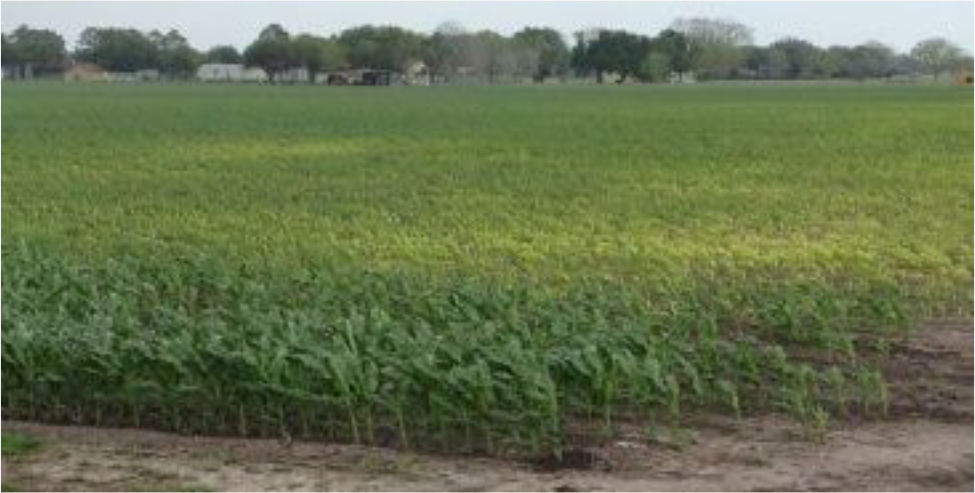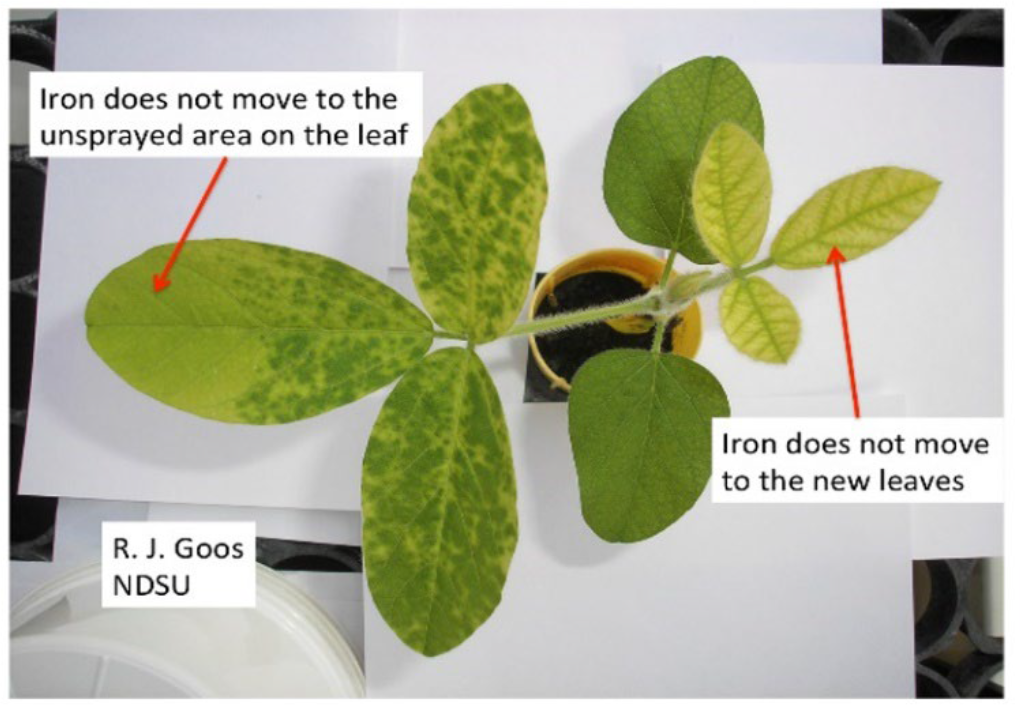⇦ Back to Fertilizer Lime Amendment Technology and Use Home
¶ Introduction
Iron deficiency chlorosis (IDC) is a problem affecting crops that grow on high pH, calcareous soils. Soybeans and sorghum most commonly exhibit symptoms of IDC, but with the right conditions corn and wheat may be affected.
Foliar applications are the most economic and effective method of using iron fertilizers to correct chlorosis in field crops.
¶ Spray Gallonage and Coverage
All foliar iron treatments require good coverage of the plant leaf with the spray solution. This means at least 20 gallons of water per acre is needed when using ground equipment (40 gallons is better). Aerial application rates should be a minimum of 5 gallons of water per acre.
Applicators should use flat fan or similar type nozzles that provide an even coverage of small droplets. Sprayers should be operated at high pressures (40 to 60 psi) to insure good coverage and canopy penetration. Nozzles should be positioned over the row to assure that foliage is thoroughly covered.
Banded or directed spray applications also minimize the amount of iron solution that is sprayed on the soil. If iron solutions are broadcast applied, higher rates may be needed to insure adequate coverage.
¶ Figure 1. Areas of Iron Deficiency Chlorosis in Grain Sorghum

¶ Timing
Iron chlorosis symptoms usually appear soon after emergence. Young, chlorotic plants are damaged because of the loss of photosynthetic activity and the subsequent loss of leaf tissue. Therefore, early and immediate treatment is crucial.
Grain sorghum and corn usually become chlorotic within the first one to two weeks after emergence. Soybeans show chlorosis symptoms soon after the first set of trifoliate leaves emerge.
IDC seems to be more pronounced during spring weather that is wet and cold, or extremely dry. Symptoms may disappear or become less obvious with warmer soil temperatures.
Chlorotic grain sorghum or corn can be treated anytime from the seedling stage until the six to eight leaf stage. Plants treated later than the six to eight leaf stage probably will not respond to the iron treatment.
Soybeans should be treated at the first signs of chlorosis. Only chlorotic areas in the field should be treated. Normal colored plants do not respond to foliar iron applications.
Chlorotic plants should green up within the two weeks following application. If they do not green up, one or two more applications at 10-day to 14-day intervals may be necessary, depending on the severity of the chlorosis.
¶ Economics
Foliar iron applied to chlorotic crops can pay off. has shown yield increases of 5 to 20 bushels for soybeans, 15 to 45 bushels for grain sorghum, and 20 to 40 bushels for corn.
Only small areas of the field are usually affected by chlorosis, so they must be spot sprayed. This may be inconvenient and uneconomic for the applicator.
If IDC is a recurring problem, growers may be better off using more long-term solutions, like planting tolerant varieties or applying manure to problem areas.
¶ Ferrous Sulfate Solution
A 2% ferrous sulfate solution has been used successfully as a foliar iron treatment. Ferrous sulfate is a soluble iron salt (20% Fe) called "iron sulfate" or "copperas".
Mix 16 pounds of ferrous sulfate in 100 gallons of water to make a 2% iron sulfate solution. Adding 8.3 gallons of UAN solution (28-0-0) per 100 gallons of iron solution enhances its ability to correct chlorosis. If UAN is not added, adding a wetting agent may be beneficial to insure better coverage and plant uptake.
Apply the iron solution at 20 to 40 gallons per acre with ground equipment and at least 5 gallons per acre with aircraft. Avoid applying the solution if rain is anticipated within 12 hours.
Once ferrous sulfate is exposed to air, it may develop yellowish oxides with are less soluble and can plug spray nozzles. The iron solution should be premixed and strained before adding it to a sprayer.
Some companies sell other iron sulfate materials for use as soil treatments. An example is a "31% ferrous sulfate" material. Do not use this material to make iron solutions because of potential incompatibility.
¶ Iron Chelates
There are a number of different iron chelates or iron complex products available for foliar application. Research has shown that Fe- EDDHA tended to provide the most consistent yield increases compared to other iron chelate products.
Fe- EDDHA is a 6% iron product. It is currently marketed by BASF as "Sequestrene Fe-138" and by West Central as “Soygreen”, though there are other manufacturers.
Fe-EDDHA should be applied to soybeans at 1 to 2.5 pounds of product per acre at the first signs of chlorosis. Spray directly over the row, adjusting the nozzle to cover the foliage and avoid wasting material on the soil. Avoid applying the solution if rain is anticipated within 12 hours.
Application may have to be repeated if chlorosis is severe. Efficacy of the treatment declines as plants get older. Fe-EDDHA treatment is usually two to four times the cost of a ferrous sulfate treatment.
¶ Figure 2. Soybean Trifoliate Leaflet

¶ References
Chatterjee, Lova, , Rasmussen, & Goos. 2017. Foliar application of iron fertilizers to control iron deficiency chlorosis of soybean. Crop Forage Turfgrass Manage. 3:1-7. doi:10.2134/cftm2017.05.0037
Sequestrene-138 product label. accessed 30Jun2022. https://assets.greenbook.net/21-03-27-16-01-2018-L68063.pdf
Soygreen product label. accessed 30June2022. https://assets.greenbook.net/L112670.pdf
Liu, Hanlon, & Li. 2022. Understanding and Applying Chelated Fertilizers Effectively Based on Soil pH. Pub. HS1208. UF/IFAS Extension, Gainesville, FL. 6 pg.
Manitoba Pulse & Soybean Growers. Iron Deficiency Chlorosis. accessed 08/11/22 https://manitobapulse.ca/2019/03/iron-deficiency-chlorosis/
¶ Notes:
*Duplicated as:
Fertilizer, Lime, & Amendment Technology & Use:
- Fertilizer Management 2.01.170
Crop Management:
- Fertility Management 3.02.005
- Grain Sorghum 3.11.200
- Soybeans 3.22.210